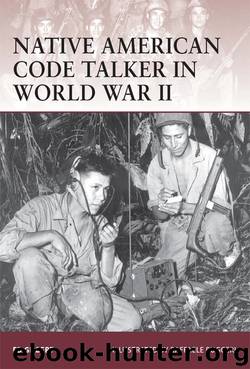Native American Code Talker in World War II by Ed Gilbert

Author:Ed Gilbert
Language: eng
Format: epub
Tags: Native American Code Talker in World War II
ISBN: 9781780966342
Publisher: Osprey Publishing
Published: 2012-02-22T16:00:00+00:00
The old TBX was being phased out, but was still in use at Peleliu in September 1944. This communicator wears his pouch of wire tools on his web belt, and atypically carries a Thompson submachine gun. (NARA)
There were few improvements in field telephony during the course of the war. This wireman is carrying the improved wire reel carrier that could be slung over the shoulder, strapped to the chest or back, or simply carried by the padded handle visible under his arm. (NARA)
Winston shoved a few items into his pack, and piled the rest of his gear together to await his possible return. He assembled the complex rig of belt suspender straps, knapsack, and web belt, and wandered out to stand with a few other dispirited men.
A few hours later Winston was in a landing boat, heading east along the coastline of Guadalcanal. After a few hours the boat turned into a broad bay, and scraped ashore near a large cloth beach marker panel. A grim-looking sergeant wearing a huge knife on his belt gathered them in, and led them past Navy construction troops. They reported to a gaunt, beak-faced man sitting under a tree. “This here’s the other code talker, Colonel.”
The commander of the 2nd Raider Battalion quickly outlined his mission. The battalion would break loose from its base, and march through the jungle to cut off Japanese troops reeling back from a defeated attack on the main perimeter. Winston would join Wilsie Bitsie, Eugene Crawford, Felix Yazzie, and Charlie Y. Begay, who had “volunteered” to join Carlson’s unorthodox unit back on Noumea. Throughout the war code talkers would find themselves in units like Raiders, parachute battalions, and reconnaissance teams because commanding officers could simply requisition communicators or other specialists like any other piece of gear.
The code talkers provided rapid communication among the widely scattered units of Carlson’s battalion, and with 1st Marine Division Headquarters. Carlson’s enthusiasm and intensity reminded Winston of the Christian missionaries on the reservation.
Like the other code talkers Winston was assigned a bodyguard. Contrary to popular lore, the job of the bodyguard was not to kill the code talker to prevent his capture, but to assure that he remained alive and on duty.
Winston was attached to one of Carlson’s infantry companies. The company patrols seemed to stumble about in the dank jungle, continually crossing streams and backtracking along their own path while every new day brought clashes with the Japanese. The Long Patrol, as Carlson’s mission would be called, was a series of such clashes. For Winston the experience was particularly hideous. According to traditional Navajo beliefs, the chindi, or spirit of a recently deceased person, lingers about the death site and will sicken the living. Here the jungle stank of unburied Japanese bodies.
On the sixth night the company set up a position in a small village. Winston noted with relief that the houses were intact. At home a house where a person had died was abandoned, with one wall knocked out so that the chindi would depart.
Download
This site does not store any files on its server. We only index and link to content provided by other sites. Please contact the content providers to delete copyright contents if any and email us, we'll remove relevant links or contents immediately.
| Africa | Americas |
| Arctic & Antarctica | Asia |
| Australia & Oceania | Europe |
| Middle East | Russia |
| United States | World |
| Ancient Civilizations | Military |
| Historical Study & Educational Resources |
1787 by Nick Brodie(1231)
The 2012 Story by John Major Jenkins(1065)
Bury My Heart at Wounded Knee by Dee Brown(1052)
Plagues and Peoples by William H. McNeill(904)
Witchcraft in Early North America by Alison Games(903)
Native American Folklore & Traditions by Elsie Clews Parson(866)
Tending the Wild by Anderson M. Kat(864)
Ada BlackJack by Jennifer Niven(858)
The Wisdom of the Native Americans by Kent Nerburn(841)
Empire of the Summer Moon by S. C. Gwynne(840)
0735220891 by Craig Johnson(813)
They Called Me Number One by Bev Sellars(782)
American Serengeti by Dan Flores(781)
The Truth About Stories by Thomas King(763)
The Killing of Crazy Horse by Thomas Powers(736)
An Inca Account of the Conquest of Peru by Ralph Bauer(721)
House of Rain by Craig Childs(716)
Sand Talk by Tyson Yunkaporta(703)
Unworthy Republic by Claudio Saunt(682)
